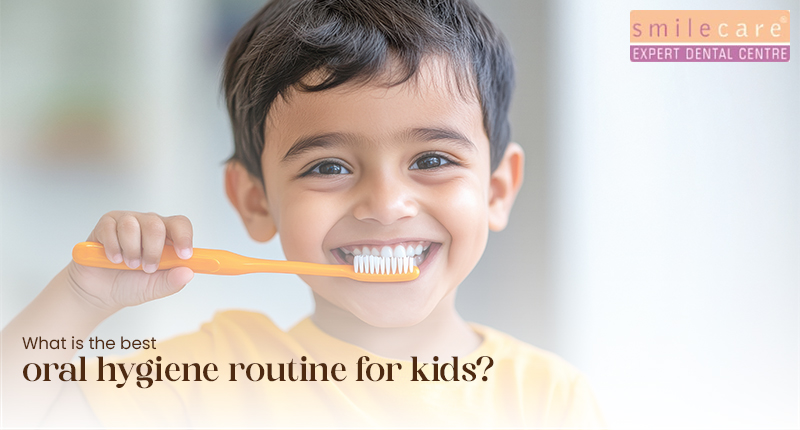Introduction
Every parent dreams of seeing their child’s bright, healthy smile. But keeping those little teeth cavity-free requires more than just occasional brushing. A proper oral hygiene routine for kids not only prevents tooth decay and gum problems but also builds lifelong habits for overall health. According to pediatric dental experts, the best routine involves daily brushing with fluoride toothpaste, flossing, a healthy diet, and regular dental visits. Let’s break this down step by step so you know exactly how to protect your child’s smile.
1. Start with Brushing Twice a Day
Brushing is the foundation of any oral care routine. Kids should brush at least twice daily, in the morning and before bed, for the morning and before bedfor two minutes each time. Use a soft-bristled toothbrush sized for children’s mouths and a pea-sized amount of fluoride toothpaste (for children over 3; younger kids should use just a smear).
- Teach them to angle the brush at 45 degrees to the gum line.
- Make small circular motions to clean every surface: outer, inner, and chewing surfaces.
- Supervise until at least age 7–8, when they have the dexterity to brush independently.
Pediatric dentists at Smile Care India emphasize fluoride’s role in strengthening enamel and preventing cavities in growing teeth.
2. Don’t Skip Flossing
Even with perfect brushing, food particles and plaque hide between teeth. That’s where flossing comes in. Kids should floss once a day, ideally before bedtime.
- For younger children, parents can help using floss picks or holders.
- Flossing prevents gum inflammation and early cavities between teeth.
- Starting early builds a lifelong habit that significantly lowers future dental risks.
3. The Role of Diet in Oral Hygiene
Oral hygiene isn’t just about brushing, it’s also about what kids eat.
- Limit sugary snacks, juices, and sticky candies that cling to teeth.
- Encourage calcium-rich foods (milk, cheese, yogurt) for stronger enamel.
- Include crunchy fruits and vegetables like apples and carrots, they help naturally clean teeth.
According to pediatric dentistry research, children who consume high sugar daily are at twice the risk of cavities compared to those with controlled sugar intake.
4. Make Dental Care Fun
Building good habits starts with making oral hygiene enjoyable.
- Use colorful toothbrushes or ones with favorite cartoon characters.
- Play a 2-minute song while brushing to ensure enough time.
- Create reward charts to encourage consistency.
By making brushing fun, children are more likely to stick with the routine.
5. Regular Dental Check-ups
A complete oral hygiene routine isn’t complete without professional care.
- Schedule the first dental visit by age 1 or within 6 months of the first tooth erupting.
- Follow up with checkups every six months.
- Dentists can detect cavities early, apply fluoride treatments, and guide proper oral development.
Smile Care India recommends routine dental visits as part of preventive care, ensuring children grow up with healthy smiles.
6. Special Tips by Age Group
Toddlers (1–3 years)
- Start brushing as soon as the first tooth erupts.
- Use a rice-grain smear of toothpaste.
- Never put kids to bed with milk or juice bottles, this causes baby bottle tooth decay.
Preschoolers (3–6 years)
- Increase toothpaste to a pea-sized amount.
- Begin flossing once two teeth touch.
- Teach spitting out toothpaste but not rinsing immediately (to keep fluoride effective).
School-age Children (6–12 years)
- Encourage independence in brushing and flossing, but check occasionally.
- Use fluoride rinses if recommended by the dentist.
- Focus on orthodontic evaluations as permanent teeth erupt.
7. Common Mistakes Parents Make
- Letting kids brush unsupervised too early.
- Using too much toothpaste (risk of swallowing fluoride).
- Allowing frequent snacking on sweets.
- Skipping dentist visits until problems arise.
Correcting these mistakes early ensures healthier outcomes.
8. Building Lifelong Habits
Good oral hygiene in childhood sets the foundation for adulthood. Kids who learn proper care early are less likely to face gum disease, cavities, or costly dental treatments later in life.
| Step | Best Practice |
| Brushing | Twice daily, 2 minutes, fluoride toothpaste |
| Flossing | Once daily, parental help for younger kids |
| Diet | Limit sugar, eat calcium-rich foods, add fruits/veggies |
| Dental Visits | First visit by age 1, then every 6 months |
| Engagement | Fun toothbrushes, songs, reward charts |
FAQs
1. At what age should kids start brushing their teeth?
As soon as the first tooth appears, usually around 6 months.
2. How much toothpaste should a child use?
Rice-grain smear for under 3 years; pea-sized for ages 3+.
3. Is flossing really necessary for kids?
Yes: once two teeth touch, flossing prevents cavities between teeth.
4. How often should children visit the dentist?
Every six months for preventive care and early detection.
5. What’s the best way to encourage kids to brush daily?
Make it fun with songs, apps, colorful brushes, and reward charts.
Conclusions
The best oral hygiene routine for kids combines daily brushing, flossing, healthy eating, and regular dental check-ups. By starting early, staying consistent, and making dental care fun, parents can protect their child’s smile for life. Following expert advice, like that from Smile Care India, ensures children not only avoid dental problems but also build confidence with a bright, healthy smile.

